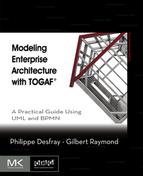ArchiMate
Abstract
ArchiMate is a modeling standard published by The Open Group. ArchiMate has defined from scratch a modeling language dedicated to TOGAF. EAP, on the other hand, has taken the route of reusing and adapting existing standards (UML, BPMN, and UML profiles), both to benefit from tools already present in the marketplace and to address a wide community of practitioners already familiar with UML and BPMN. This chapter briefly presents the ArchiMate standard and shows how ArchiMate and EAP are mapped.
ArchiMate is a modeling standard published by The Open Group. ArchiMate has defined a modeling language dedicated to TOGAF from scratch. EAP, on the other hand, has taken the route of reusing and adapting existing standards (UML, BPMN, and UML profiles), both in order to benefit from tools already present in the marketplace and to address a wide community of practitioners already familiar with UML and BPMN.
This chapter briefly presents the ArchiMate standard and shows how ArchiMate and EAP are mapped.
14.1 The ArchiMate standard
The ArchiMatea modeling language is dedicated to enterprise architecture modeling. Originally initiated outside of The Open Group and TOGAF, it then joined The Open Group and introduced mappings to TOGAF. ArchiMate often refers to TOGAF when specifying specific terms. ArchiMate is now linked to the evolution of TOGAF and is currently evolving to fit TOGAF more closely.
ArchiMate has a core modeling language, and extensions, such as the “Motivation” extension (goals, objectives, etc.) and the “Implementation and Migration” extensions. ArchiMate, like EAP, proposes predefined viewpoints. These viewpoints, as specified by TOGAF, can be adapted to the context of the enterprise and the focus of the enterprise architecture activity.
ArchiMate structures a model according to the following principles:
• A “Business Architecture” level, which is broken down into the following sublevels:
• Product
• Process
• Organization
• An “Application Architecture” level, which is broken down into the following sublevels:
• Application
• A “Technology Architecture” level
ArchiMate therefore uses three top-level TOGAF architecture domains, with data architecture being split between business architecture (Information) and application architecture (Data). The business level handles business information, enterprise organization, business processes, and products. The organization of the model in this book uses the same principle (Figure 14.1).
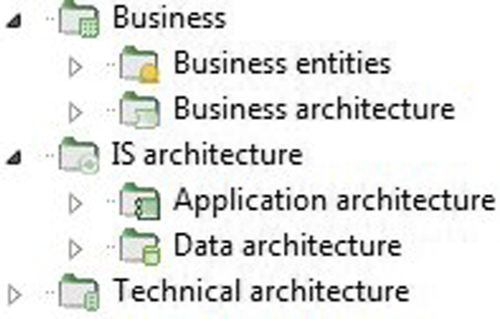
This structuring is by no means mandatory. The definition of enterprise-specific viewpoints can notably lead to different meanings. For example, we can imagine an additional viewpoint dedicated to system security.
The core language of ArchiMate consists of three main types of elements: active structure elements (business actors, application components, devices, etc.), behavior elements (processes, interactions, use cases, etc.), and passive structure elements (business entities, etc.).
• Active structure elements are entities capable of performing behavior.
• Behavior elements are units of activity performed by one or several active structure elements.
• Passive structure elements are objects on which behavior is performed, such as data.
ArchiMate is strongly focused on the concept of “service,” which is a unit of functionality that a system exposes to its environment.
Besides the core aspects of ArchiMate, there are aspects not explicitly covered by ArchiMate, such as goals, principles and requirements, risk and security, governance, policies and business rules, costs, performance, timing, planning, and evolution.
The “Motivation” extension adds “motivational” concepts such as goals, objectives, principles, requirements, stakeholders, drivers, and assessments.
The “Motivation” extension enables the support of requirements management, the preliminary phase and phase A of TOGAF.
ArchiMate’s “Implementation and Motivation” extension adds concepts to support the later ADM phases, related to the implementation and migration of architecture: phase E (Opportunities and Solutions), phase F (Migration Planning), and phase G (Implementation Governance). The main concepts are “work package,” “deliverable,” and “gap.”
14.2 ArchiMate to EAP correspondence examples
We are now going to present several model examples, taken from the ArchiMate standard, and show how they translate in EAP.
14.2.1 Business layer
EAP distinguishes organization units as a specific kind of actor (Figures 14.2 and 14.3).
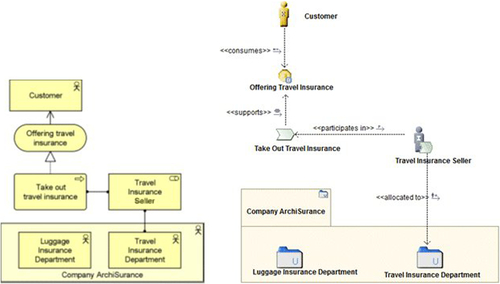
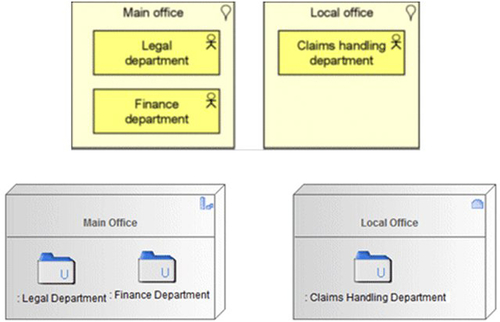
By reusing UML, EAP takes advantage of its complete and detailed metamodel. In this example, the deployed occurrences are specific entities within EAP, thus enabling specific properties and values to be allocated to them.
14.2.2 Application layer
Many ArchiMate concepts are inspired by the UML2 standard. EAP directly reused the UML2 definition. As in TOGAF and EAP, the main concept is “Application Component.”
As shown in Figure 14.4, we see in this example that EAP takes advantage of the UML2 deployment facility. EAP benefits from UML assembly mechanisms through ports and connectors.
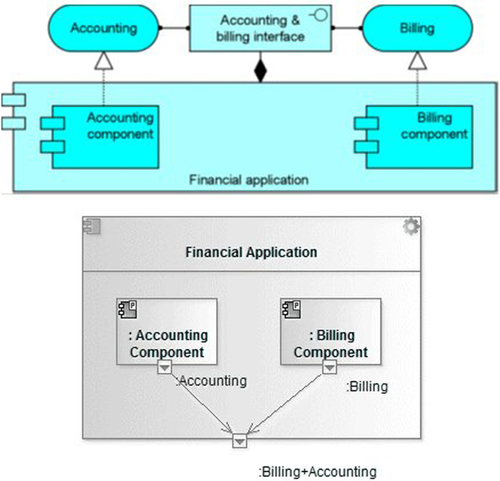
14.2.3 Technology layer
UML2’s deployment mechanism is very useful at this stage to express, for example, how application components are distributed on execution hardware. ArchiMate reuses the UML2 “Node” concept, but in a simpler, more restricted context (Figures 14.5 and 14.6).


14.3 Detailed mapping
The following table presents Modeliosoft Enterprise Architect Solution's support of the ArchiMate standard.
Please note that wherever there is a discrepancy between names, TOGAF terms have been chosen over ArchiMate terms.
Notations are primarily based on the UML and BPMN standards.
From the examples and this table, we can see that there are many similarities. EAP can be considered as a way to implement ArchiMate by reusing UML and BPMN, or in short as a UML profile for ArchiMate.
| ArchiMate Concept | EAP/TOGAF Concept | Comments | Notation |
| Business Layer | |||
| Business actor | Actor | Internal actor and external actor are explained by EAP | |
| Business role | Role | ||
| Business collaboration | Business collaboration | ||
| Business interface | No real usage identified | ||
| Location | Location | Headquarters and sites | |
| Business object | Business entity | ||
| Business process | Business process | ||
| Business function | Function | ||
| Business interaction | Business interaction | UML interaction | |
| Business event | Event | ||
| Business service | Business service | ||
| Representation | No real usage identified | ||
| Meaning | Term | This concept is little developed in ArchiMate, but extensively developed in the Modelio “dictionary” | |
| Value | Value factor on Function | ||
| Product | Product | ||
| Contract | Service contract | Preconditions, postconditions, invariants | |
| Application Layer | |||
| Application component | Application component | Enterprise Architect Solution breaks components down using component typology to facilitate sound SOA structuring | |
| Application collaboration | Application collaboration | ||
| Application interface | Required or provided services | ||
| Data object | Entity or business entity | ||
| Application function | No real usage identified. The notion of “Function” does not seem to be relevant to “Application Architecture,” and does not fit an SOA-oriented approach | ||
| Application interaction | UML interaction on collaboration | ||
| Application service | Information service | ||
| Technical Layer | |||
| Node | Node | Generic element | |
| Device | Server, workstation, etc. | More detailed list on EAP | |
| Network | Bus | ||
| Communication path | Network link | ||
| Infrastructure interface | Port | ||
| System software | Utility component | ||
| Infrastructure function | No real usage identified | ||
| Infrastructure service | IS service | ||
| Artifact | Technology artifact | ||
| Relationships | |||
| Association | Association | ||
| Access | Flow | ||
| Use by | Consumes | “Consumes” is reserved for actors. For other elements, backward “supports” links | |
| Realization | Component realization | Specialized in Enterprise Architect Solution on components | |
| Assignment | Initiator of; participates in; owner of | Enterprise Architect Solution provides more specialized links | |
| Aggregation | Aggregation | ||
| Composition | Composition | ||
| Flow | Flow | ||
| Triggering | Flow | ||
| Grouping | Packages and embedding | ||
| Junction | BPMN junction | ||
| Specialization | Generalization | ||
| Extensions | |||
| Language extension mechanisms | Profiles, MDA | ||
| Driver, Goal | Goals | Detailed by specific properties and diagrams in Modelio. The distinction between Driver and Goal can be made through different “containers” or by using specific properties | |
| Requirement | Requirement | Detailed by specific properties and diagrams in Modelio | |
| Aggregation | Part | ||
| Realization | Satisfies | OMG SysML norm | |
| Influence | Positive influence; negative influence | ||
| Aggregation | Aggregation | ||
| Deployment | Modeliosoft Enterprise Architect Solution enables application components to be directly deployed on nodes | ||
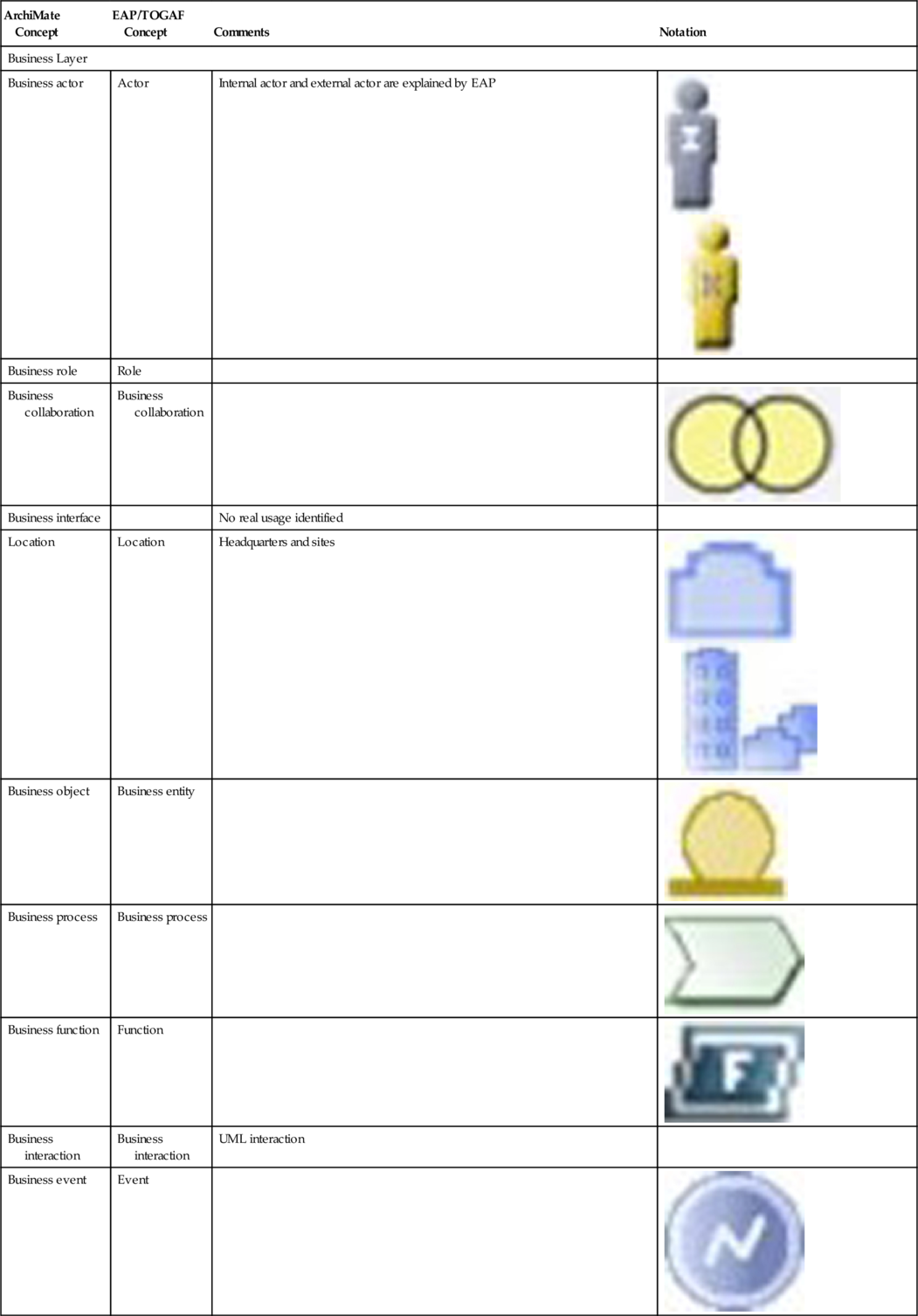
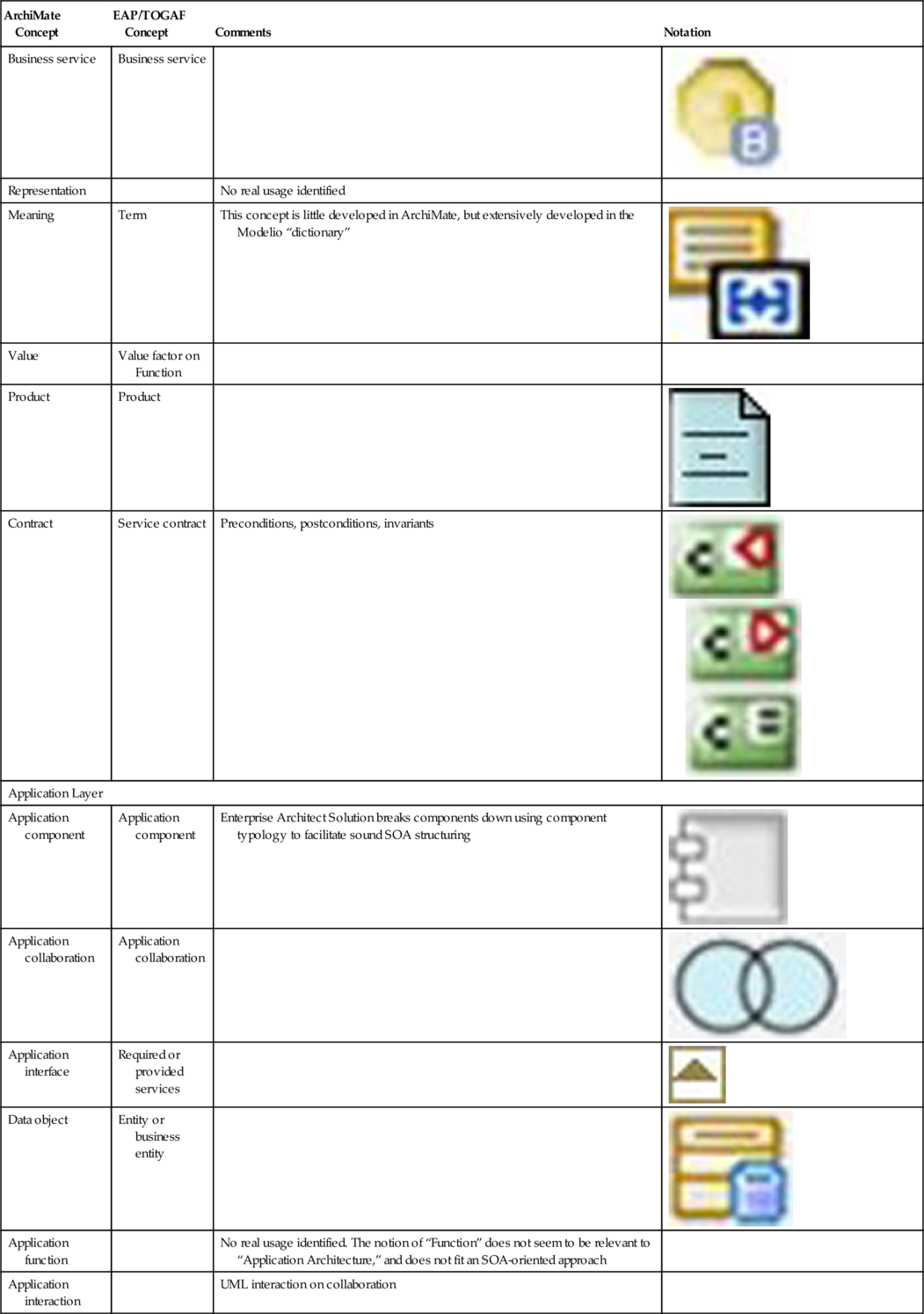


14.4 Fundamental concepts
The following fundamental concepts were introduced in this chapter:
• ArchiMate: Modeling language dedicated to enterprise architecture modeling; related to TOGAF.
